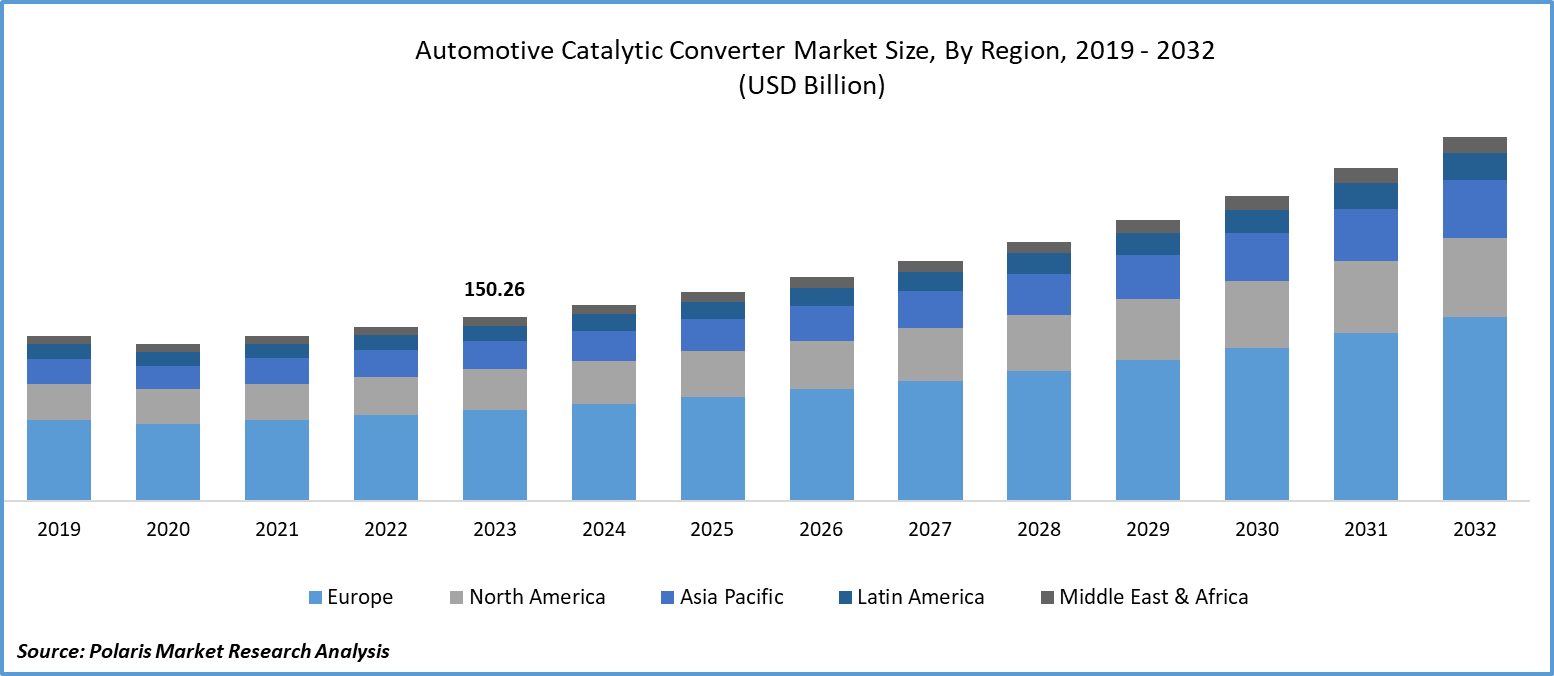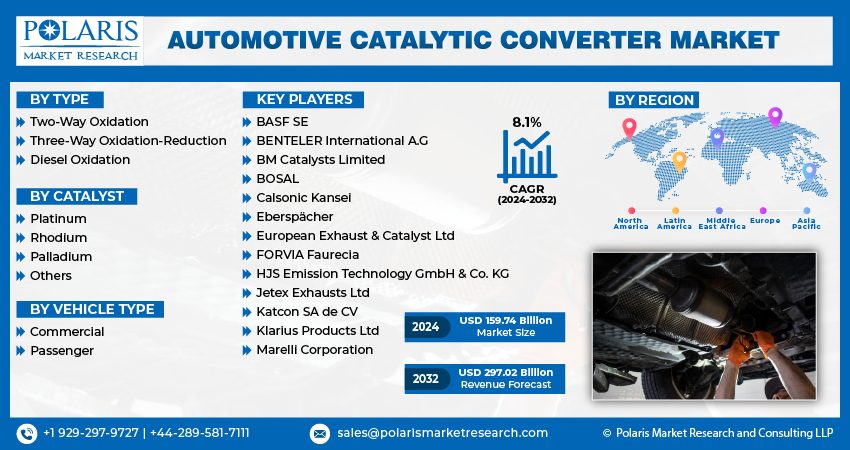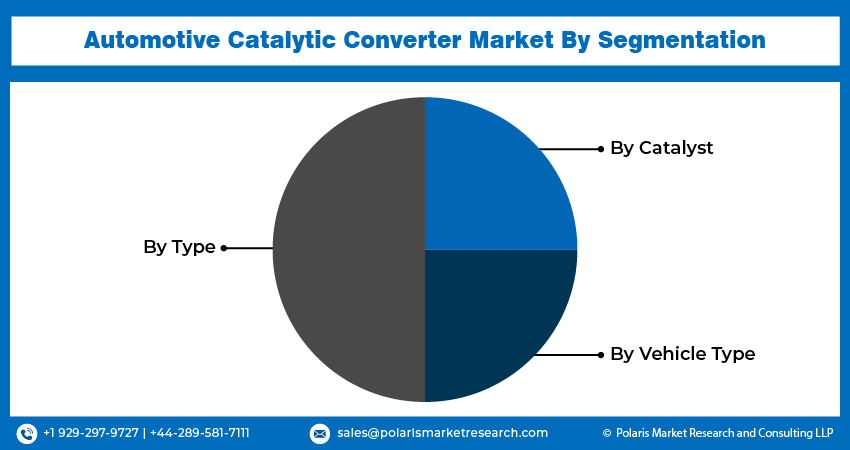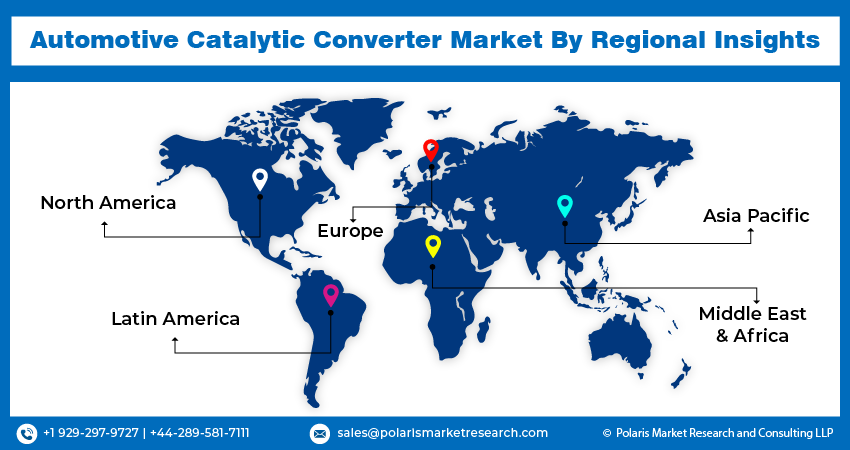
Automotive Catalytic Converter Market Share, Size, Trends, Industry Analysis Report
By Type (Two-Way Oxidation, Three-Way Oxidation-Reduction Catalytic Converter); By Catalyst; By Vehicle Type; By Region; Segment Forecast, 2025 - 2034
- Published Date:May-2025
- Pages: 165
- Format: PDF
- Report ID: PM1423
- Base Year: 2024
- Historical Data: 2020-2023
The global automotive catalytic converter market was valued at USD 154.6 billion in 2024 and is forecasted to grow at a CAGR of 4.20% from 2025 to 2034. The market is growing due to increasingly stringent emission norms and a rising number of vehicles on the road.
Market Overview
The automotive catalytic converter serves as a vital element within a vehicle's exhaust system, playing a pivotal role in mitigating harmful emissions and safeguarding the environment. Essentially, it operates as a specialized apparatus engineered to convert toxic gases and pollutants generated during fuel combustion into less environmentally detrimental substances before their release into the atmosphere. Among the primary pollutants targeted for transformation by catalytic converters are nitrogen oxides (NOx), carbon monoxide (CO), and unburned hydrocarbons (HC).
For instance, in January 2023, BM Catalysts revealed the latest new-to-range DPF, catalytic converter, and pipe references.

To Understand More About this Research:Request a Free Sample Report
The global automotive catalytic converter market development is experiencing significant growth, primarily due to the expansion of the automobile sector. The increasing adoption of catalytic converters is being propelled by the implementation of stringent emission regulations by governments worldwide aimed at reducing air pollution and promoting environmental sustainability. Catalytic converters play a crucial role in reducing harmful emissions from vehicles, thus helping to mitigate their environmental impact.
Moreover, there is a growing global awareness of environmental pollution, particularly concerning air quality. This increasing awareness has led to rising demand for automobile catalytic converters as part of efforts to address environmental issues. As sustainability becomes a more pressing concern, there is a growing trend towards vehicles with lower environmental impact. Catalytic converters are integral to this trend, as they are effective in reducing harmful emissions and are considered a vital component in addressing environmental challenges.
Market Dynamics
Market Drivers
Government Regulations are Projected to Spur the Product Demand
Government regulations that impose strict pollution restrictions play a pivotal role in driving the growth. These regulations mandate the use of effective catalytic converters, which are designed to reduce harmful emissions such as hydrocarbons (HC), nitrogen oxides (NOx), and carbon monoxide (CO) from vehicle exhaust. For instance, in the European Union, the Euro 6 standards set stringent limits on vehicle emissions, requiring the use of advanced catalytic converters to meet these standards. Similarly, in the United States, the Environmental Protection Agency (EPA) has implemented Tier 3 standards that require automakers to install advanced catalytic converters to reduce emissions. These regulations are not limited to specific regions and are also prevalent in other parts of the world. Many countries and regions have adopted laws and standards comparable to the Euro 6 and EPA Tier 3 standards to control vehicle emissions and protect air quality.
Increasing Demand for Fuel-Efficient Automobiles
The cost of gasoline rises, and environmental concerns become more prominent, growing demand for fuel-efficient vehicles. People are increasingly prioritizing fuel efficiency when purchasing cars. Catalytic converters play a crucial role in this aspect by reducing exhaust pollutants, which helps maximize engine combustion efficiency and minimize fuel consumption. As a result, the importance of cars equipped with efficient catalytic converters is increasing, reflecting consumers' rising emphasis on fuel economy.
Market Restraints
Cost Associated With the Materials
Precious metals such as rhodium, palladium, and platinum play a crucial role in catalytic converters by serving as catalysts that facilitate chemical reactions to reduce harmful emissions from vehicles. These metals are used in small amounts but are essential for the converter's efficiency in converting pollutants into less harmful substances. However, the prices of these precious metals are subject to significant fluctuations in the automotive catalytic converter industry outlook. Such fluctuations can have a substantial impact on the manufacturing costs of catalytic converters. As the prices of these metals rise, the cost of producing catalytic converters increases as well. As a result, manufacturers may need to adjust their pricing to reflect these higher production costs. This could lead to increased prices for consumers purchasing vehicles with catalytic converters, as manufacturers seek to offset the higher costs of the precious metals used in the converters.
Increasing Adoption of Electric Vehicles
The increasing popularity and adoption of electric vehicles (EVs) are expected to present long-term challenges for the industry expansion. As more consumers switch to EVs, the demand for traditional internal combustion engine (ICE) vehicles that require catalytic converters could decrease. This shift in consumer preference towards EVs could impact the growth of the catalytic converter market as the need for these devices in ICE vehicles decreases.

Report Segmentation
The market is primarily segmented based on type, catalyst, vehicle type, and region.
|
By Type |
By Catalyst |
By Vehicle Type |
By Region |
|
|
|
|
To Understand the Scope of this Report:Speak to Analyst
Automotive Catalytic Converter Market Segmental Analysis
By Type Analysis
The two-way oxidation segment is projected to grow at the fastest CAGR during the forecast period. The increasing prevalence of gasoline-powered vehicles, particularly in emerging country regions, is driving the industry's growth. As the number of automobiles on the road rises, there is an increasing need for efficient pollution control systems. Automobile manufacturers opt for two-way oxidation converters because they offer the most cost-effective solution for gasoline engines.
The three-way oxidation-reduction segment led with a substantial revenue share in 2024. Advancements in material science and catalytic converter technology have significantly influenced the growth of this segment. Continuous research and development efforts have led to the emergence of novel catalyst compositions and enhanced converter designs. These advancements have yielded catalytic converters that boast improved durability and efficiency in transforming harmful emissions into less detrimental substances.
The introduction of these new technologies has garnered interest from automakers eager to incorporate cutting-edge emission control systems into their vehicles. By embracing these advanced catalytic converters, automakers have the opportunity not only to meet but also to surpass regulatory emission standards. This, in turn, contributes to enhancing the environmental performance of their vehicles.
By Catalyst Analysis
The palladium segment accounted for the largest share in 2024 and is likely to retain its position throughout the automotive catalytic converter market forecast period. Palladium is highly effective in catalyzing the oxidation of hydrocarbons, making it a valuable component in catalytic converters. Additionally, palladium exhibits impressive thermal stability, which is crucial for maintaining catalytic efficiency under high temperatures. Moreover, among the three metals commonly used in catalytic converters (platinum, rhodium, and palladium), palladium is currently the most cost-effective option.
However, despite these advantages, palladium's susceptibility to being poisoned by certain contaminants in vehicular emissions limits its utility in automotive components. These contaminants, known as poisons, can accumulate on the surface of the palladium catalyst, reducing its effectiveness over time. As a result, while palladium is a desirable choice for catalytic converters due to its performance and cost-effectiveness, its sensitivity to poisons necessitates careful consideration in the design and operation of these components.
The platinum segment is expected to grow significantly over the next few years. Platinum is reasonably resistant to toxins, including lead, phosphorus, and sulfur, and is an effective oxidation catalyst. Platinum has been used in place of rhodium and palladium due to their limited activity for converting nitrogen oxides, susceptibility to high temperatures, and expensive cost.
By Vehicle Type Analysis
The commercial segment is anticipated to grow at the fastest CAGR during the automotive catalytic converter forecast period. The industry is expanding as a result of tightening government limits on vehicle emissions from commercial vehicles. Vehicles owned by the public and commercial sectors are using automotive catalytic converters more frequently to limit the amount of nitrogen, carbon, and other hazardous substances that are released into the atmosphere.
Global Automotive Catalytic Converter Market, Segmental Coverage, 2019 - 2032 (USD Billion)

Source: Secondary Research, Primary Research, PMR Database and Analyst Review
Regional Insights
The Europe Region Dominated the Global Market With the Largest Share in 2024
The Europe region dominated with the largest share in 2024 and is expected to maintain its dominance over the anticipated period. The European region has a multitude of renowned vehicle manufacturing enterprises. This region is witnessing a surge in demand for catalytic converters, primarily driven by stringent emission regulations such as Euro-VI and the rapid pace of research and development. Under the Euro VI emission standard, automotive manufacturers are mandated to integrate catalytic converters into all vehicles to meet environmental regulations. These factors are expected to bolster automotive catalytic converter market growth in the region.
The Asia Pacific region is expected to be the fastest-growing region with a healthy CAGR during the automotive catalytic converter market forecast period. The significant growth in the number of cars in this region can be attributed to several factors, including increased urbanization, rapid population growth, improved living standards, expansion of the industrial sector, and higher personal incomes. As car manufacturing has surged, so too have car emissions, leading to elevated levels of air pollution and contributing to global warming. In response, some developed and emerging nations, such as China, Japan, and India, have implemented stringent regulations on automobile emissions. For instance, in 2020, China and India plan to adopt emissions standards equivalent to the European Union's Euro VI, known as China VI and BS VI, respectively. It is anticipated that there will be a huge demand for many after-treatment devices due to these notable trends in the direction of stricter emission regulations. Leading nations in this region for after-treatment devices include China and Japan.
GLOBAL AUTOMOTIVE CATALYTIC CONVERTER MARKET, REGIONAL COVERAGE, 2019 - 2032 (USD Billion)

Source: Secondary Research, Primary Research, PMR Database and Analyst Review
Competitive Landscape
The automotive catalytic converter market is fragmented and is anticipated to witness competition due to several players' presence. Major catalytic converter providers in the market are constantly upgrading their technologies to stay ahead of the competition and to ensure efficiency, integrity, and safety. These players focus on partnership, product upgrades, and collaboration to gain a competitive edge over their peers and capture a significant market share.
Some of the major players operating in the global automotive catalytic converter market include:
- BASF SE
- BENTELER International A.G
- BM Catalysts Limited
- BOSAL
- Calsonic Kansei
- Eberspächer
- European Exhaust & Catalyst Ltd
- FORVIA Faurecia
- HJS Emission Technology GmbH & Co. KG
- Jetex Exhausts Ltd
- Katcon SA de CV
- Klarius Products Ltd
- Marelli Corporation
Recent Developments
- In September 2024, AP Emissions Technologies released 19 new CARB-certified catalytic converters in September 2024, covering over 376,000 vehicles. The company ensured compliance with California emissions standards and made the parts immediately available through its catalog for various vehicle applications
- In May 2022, the Connecticut Government enacted Public Act 22-43, which establishes guidelines for the purchase and sale of automotive catalytic converters by various entities. These include automobile recyclers, scrap catalytic converter processors, junkyard dealers and owners, and motor vehicle repair shops.
Report Coverage
The automotive catalytic converter market report emphasizes on key regions across the globe to provide a better understanding of the product to the users. Also, the report provides market insights into recent developments and trends and analyzes the technologies that are gaining traction around the globe. Furthermore, the report covers an in-depth qualitative analysis pertaining to various paradigm shifts associated with the transformation of these solutions.
The report provides a detailed analysis of the market while focusing on various key aspects such as competitive analysis, type, catalyst, vehicle type, and their futuristic growth opportunities.
Automotive Catalytic Converter Market Report Scope
|
Report Attributes |
Details |
|
Market size value in 2025 |
USD 161.09 billion |
|
Revenue forecast in 2034 |
USD 234.70 billion |
|
CAGR |
4.20% from 2024 – 2032 |
|
Base year |
2024 |
|
Historical data |
2020 – 2023 |
|
Forecast period |
2025 – 2034 |
|
Quantitative units |
Revenue in USD billion and CAGR from 2025 to 2034 |
|
Segments covered |
By Type, By Catalyst, By Vehicle Type, By Region |
|
Regional scope |
North America, Europe, Asia Pacific, Latin America, Middle East & Africa |
|
Customization |
Report customization as per your requirements with respect to countries, region, and segmentation. |
FAQ's
key companies in Automotive Catalytic Converter Market are BASF SE, BENTELER International A.G, BM Catalysts Limited, BOSAL.
The automotive catalytic converter market is projected to exhibit a CAGR of 4.20% during the forecast period.
The automotive catalytic converter market report covering key segments are type, catalyst, vehicle type and region.
The key driving factors in the automotive catalytic converter market are the increasing demand for fuel-efficient automobiles and the implementation of government regulations.
The global automotive catalytic converter market size is expected to reach USD 234.70 billion by 2034.
